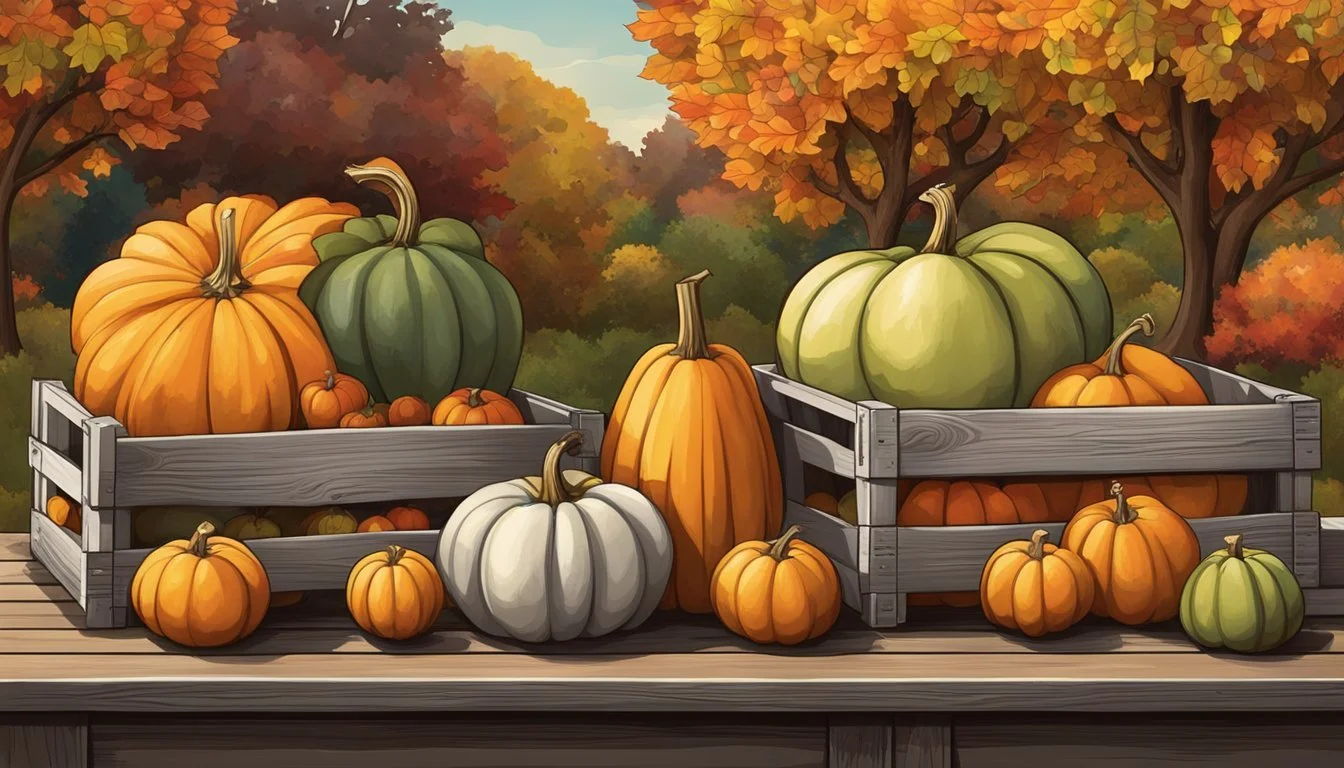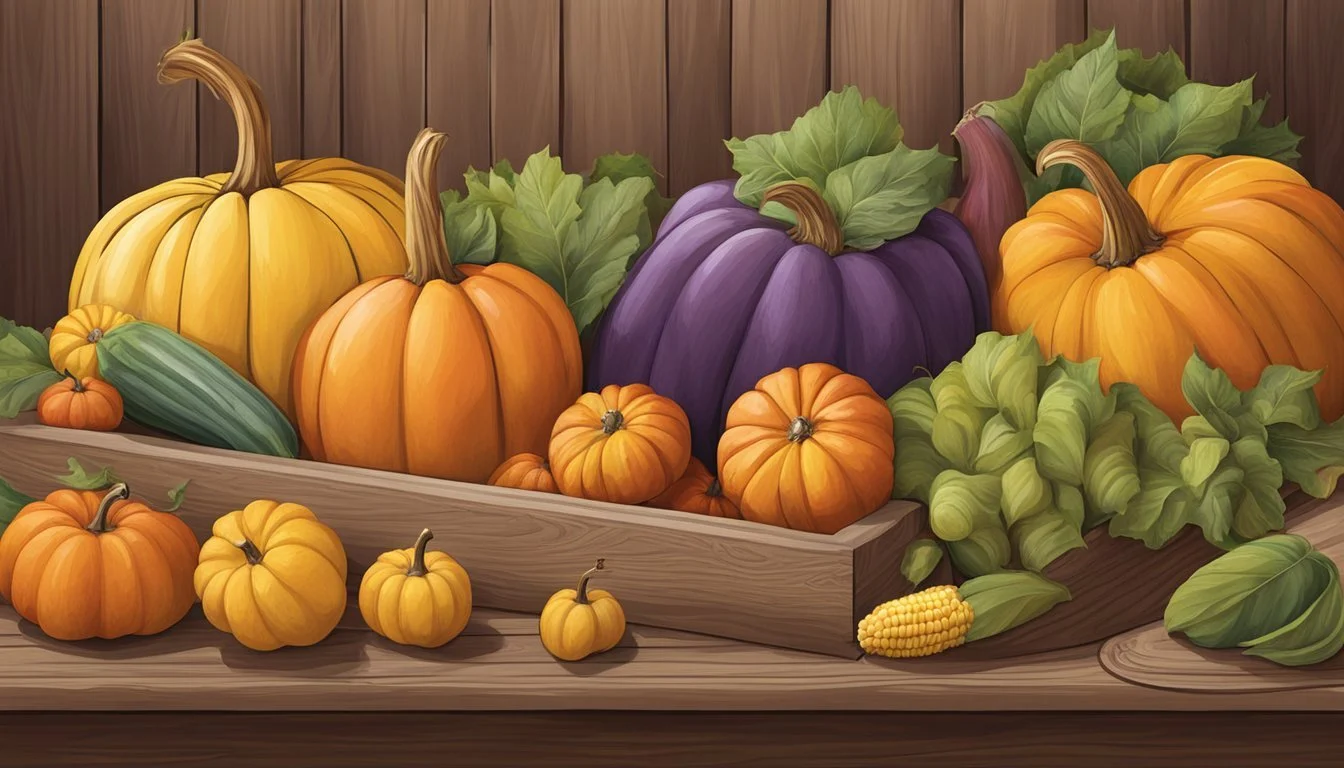Montana Seasonal Fruit & Vegetables in October
Your Guide to Autumn Harvest
This Article is Part of our Montana Seasonal Fruit & Veg Calendar
October in Montana offers a cornucopia of seasonal fruits and vegetables that capture the essence of fall's bounty. During this time, local farmers' markets and stores are brimming with fresh produce that has been gathered at its peak, ensuring optimal flavor and nutritional value. Hearty root vegetables and late-harvest fruits are signature staples during this month. Apples, a versatile and beloved fruit, come into their own, with various types available, from tart to sweet, perfect for pie-making or enjoying fresh. Sweet potatoes (What wine goes well with sweet potatoes?), another hardy produce item, offer not only a rich taste but also a wealth of health benefits.
Vegetable-wise, October sees the harvest of robust greens and earthy vegetables that thrive in cooler temperatures. Montana's soil yields nutrient-rich produce such as broccoli, chard, and kale, ideal for nourishing soups and stews. Cauliflower also makes its seasonal appearance, ready to be transformed into warming dishes or enjoyed as a healthy raw snack. Local growers take pride in the variety and quality of their produce, with many leveraging sustainable techniques to extend the growing season and provide Montanans with the best of their harvest.
Overall, a produce guide for
October's Harvest Calendar for Montana
As October ushers in the crisp autumn air in Montana, local farms and markets brim with an array of seasonal produce. The abundance of harvest during this month includes a variety of robust flavors from both the fruit and vegetable spectrum, essential for hearty fall recipes.
Prime Fruits
Apples: A staple of the fall season, apples reach their peak in October. Varieties such as McIntosh, Honeycrisp, and Gala provide a versatile range for eating fresh or for use in baked goods.
Pears: Delicate pears are abundant, with Bartlett and Bosc making notable appearances in Montanan orchards.
Cranberries: Although not as widespread, cranberries can be found during this month and are ideal for preserves and festive dishes.
Grapes: Vineyards harvest various grape varieties that thrive in the cooler climate, perfect for fresh eating or wine-making.
Vegetable Picks
Pumpkins: Synonymous with fall, pumpkins become ready for harvest, lending themselves to decoration, carving, and cooking.
Winter Squash: Varieties like acorn, butternut, and spaghetti squash are gathered, providing a comforting, sweet, and nutty flavor.
Sweet Potatoes: Hearty and rich, sweet potatoes start to appear in the fields, offering a nutritious and versatile ingredient for a multitude of dishes.
Broccoli: Healthy and hardy, broccoli is harvested and offers a crunchy addition to both raw and cooked meals (how long do cooked meals last?).
Kale and Spinach: These leafy greens are in prime condition to be picked, offering a nutritious boost to autumn salads and warm dishes.
Health Benefits of Seasonal Produce
Consuming seasonal produce in October in Montana offers optimal nutrition and health benefits due to the fresh harvest.
Nutrient Highlights
Sweet Potatoes: Loaded with fiber and antioxidants, they support a healthy digestive system and combat oxidative stress.
Leafy Greens: Such as kale and spinach, are densely packed with iron and Vitamin K, essential for maintaining strong bones and blood health.
Root Vegetables: Offer a rich supply of vitamins and minerals. Carrots, for example, deliver vision-supporting Vitamin A.
Salads: Ingredients harvested in their peak season such as beets (how long do beets last?) and lettuce provide a burst of flavor and nutrients.
Fiber: Present in abundance in seasonal vegetables like turnips, fiber promotes a feeling of fullness and aids in digestion.
Vitamins and Antioxidants: Cruciferous vegetables like brussels sprouts are high in Vitamins C and K as well as antioxidants, which are integral for immune system support and overall wellness.
Culinary Tips and Tricks
In the crisp month of October in Montana, seasonal produce offers a rich palette of flavors that can be enhanced through various cooking techniques and innovative recipes. Embracing the diversity of herbs and the natural sweetness of fall fruits and vegetables, this section provides guidance on harnessing the changing season's bounty.
Cooking Methods
Roasting:
Vegetables: Utilize the oven to transform root vegetables into caramelized, roasted dishes (What wine goes well with roasted dishes?). Adding a sprinkle of sugar can enhance the natural sweetness of carrots, parsnips, or sweet potatoes.
Herbs: Tougher herbs like rosemary and thyme withstand the dry heat and infuse roasted vegetables with aromatic flavors.
Baking:
Pies: Embrace the season's sweet and tart fruits, such as apples and blackberries, by baking them into pies. Incorporate a blend of sugar and spices like cinnamon for depth of flavor.
Casseroles: Combine late-harvest vegetables with rich cheeses and bake until golden for hearty casseroles that warm the soul.
Recipe Ideas
Salads:
Mixed greens paired with roasted squash or beets offer a hearty base for salads. Toss them with a vinaigrette made from fresh, local herbs for a refreshing side dish.
Soups:
Soups benefit from the depth of October's produce. A velvety butternut squash (how long does butternut squash last?) soup or a robust stew with potatoes and carrots celebrate the essence of fall.
Combine these methods and ideas to fully capture the essence of Montana's October offerings in your culinary endeavors.
Preparing and Storing Your Bounty
In Montana, October heralds the end of the harvest season for many vegetables. Proper storage and preservation techniques are crucial for extending the bounty of crops like celery (how long does celery last?), carrots, beets, onions, and potatoes well into the winter months.
Storage Techniques
When it comes to storage, maintaining the freshness and edibility of vegetables like celery, carrots, beets, onions, and potatoes requires an understanding of their individual needs. Here is a breakdown of optimal conditions:
Celery: Store in the refrigerator, wrapped in aluminum foil to retain crispness.
Carrots: Place them in a container filled with moist sand or peat moss and keep in a cold, dark location.
Beets: Similar to carrots, store beets in moist sand in a cool environment.
Onions: They require a dry, well-ventilated area; hanging them in mesh bags is ideal.
Potatoes: Keep them in a dark, cool space with good air circulation to prevent sprouting.
Preservation Methods
For longer-term storage, preservation through canning, freezing, and drying is effective:
Canning: Works well for a variety of vegetables and is ideal for making beets pickles or carrot relish. Ensure the process follows safe canning practices to prevent spoilage.
Freezing: Blanched carrots and celery maintain quality when frozen. Beets can be cooked and sliced before freezing for later use.
Drying: While not common for vegetables like carrots and potatoes, seeds from harvested vegetables can be dried and stored for planting the following season or for use as seasoning.
Each vegetable has unique requirements, so it is imperative to understand the correct methods for storage and preservation to ensure they remain nutritious and flavorful throughout the offseason.
Where to Find Local October Produce
In Montana, October's bounty can be found in a variety of settings, each offering a unique experience for the consumer seeking fresh, local produce. Farmers Markets are a hub for local growers to sell their crops directly to consumers. They can explore seasonal offerings, such as winter squash and apples, which are often at their peak during this month. The vibrant community atmosphere of these markets provides an opportunity for buyers to engage with growers, learn about farming practices, and discover cooking tips for seasonal produce.
Local Farms often have roadside stands or on-farm stores where visitors can purchase produce that's been harvested at its prime. These spaces allow individuals to support local agriculture and enjoy the freshness that comes with purchasing directly from the source. Some farms may also host harvest festivals or pumpkin patches, adding a festive element to the shopping experience.
Community Supported Agriculture (CSA) programs are another avenue for sourcing October produce. Members typically receive a share of the harvest, which includes a variety of the season's best vegetables and fruits. CSAs encourage a closer connection between the farmer and the consumer and foster a mutual commitment to local, sustainable agriculture.
Venue Type Expected Finds Additional Notes Farmers Markets Winter squash, apples, root vegetables Check local listings for schedules; often weekend mornings Local Farms Pumpkins, corn, artisanal goods On-farm stores or stands; may have limited hours CSAs Mixed produce boxes Subscription required; pickups/deliveries vary by program
Consumers are advised to research and connect with local farms and markets through websites, social media, or community boards to verify availability and times. By frequenting these outlets, they support Montana's agricultural community and gain access to some of the freshest seasonal produce available.






